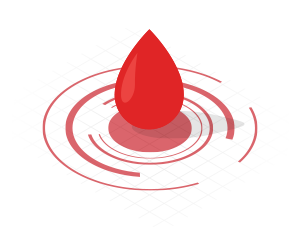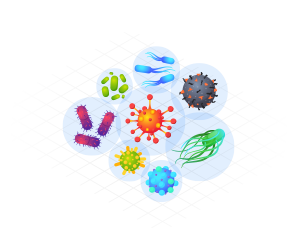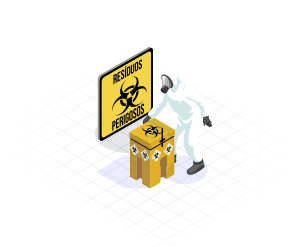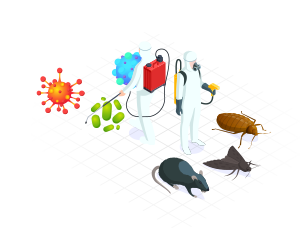


“disinfestation”, despite conveying the notion of being something identical, there are many differences between the two, let’s see:
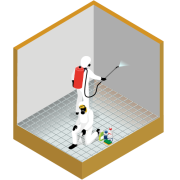
- Disinfestation: Eliminating infestation (pest control), the extermination or destruction of insects (cockroaches, flies, mosquitoes, bedbugs, fleas, etc.), rodents (rats, mice) and other creatures, many of which are considered urban pests. The expression is only related to infestation, which is a term associated with pests, infestations of invasive pests, and not with microorganisms.
- Disinfection: Eliminating what infects is the method capable of destroying almost all pathogenic microorganisms (e.g. viruses, bacteria and fungi), which transmit numerous infectious diseases to humans, many of them fatal. The process of eliminating all microorganisms (microbial life forms) is sterilization.
Read more
Fogging or spraying… It’s wrong!

We also come across incorrect statements from several pest control companies, where they wrongly state that it is enough to simply nebulize or spray a disinfectant product into the area to be treated, thus carrying out an effective action in disinfecting the place, sometimes with a long period of action and prohibition of access to these spaces.
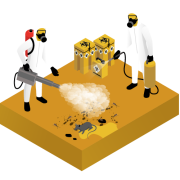
The application of a biocidal disinfectant product that has a long period of action and that requires the closure of the site, not only proves its low level and spectrum of action, but also its high degree of toxicity, not providing guarantees of the effective elimination of biological agents, therefore no disinfection action is carried out or can be legitimately attested.
Certified disinfection

THE DEATHCLEAN® carries out, in a certified manner, using high-performance biocidal disinfectant products, the correct and proven disinfection of contaminated areas or areas at high risk of exposure to contamination.

We can only consider the disinfection service when it effectively involves the elimination of pests, as the disinfection service of contaminated places requires the elimination of microorganisms that transmit infectious diseases and not urban pests.
RELATED INFORMATION

WHAT ARE THE DIFFERENCES?
We often come across the use of the word “disinfection” associated with the well-known pest control service, “disinfestation”. Although it conveys the notion of being something identical, there are many differences between the two, let’s see:
- Disinfestation: Eliminating infestation (pest control), the extermination or destruction of insects (cockroaches, flies, mosquitoes, bedbugs, fleas, etc.), rodents (rats, mice) and other creatures, many of which are considered urban pests. The expression is only related to infestation, which is a term associated with pests, infestations of invasive pests, and not with microorganisms.
- Disinfection: Eliminating what infects is the method capable of destroying almost all pathogenic microorganisms (e.g. viruses, bacteria and fungi), which transmit numerous infectious diseases to humans, many of them fatal. The process of eliminating all microorganisms (microbial life forms) is sterilization.
As described, “disinfestation” and “disinfection” are very distinct concepts and actions. In the “disinfestation” process, the elimination of pathogenic microorganisms cannot be proven, and for this to happen it is necessary to resort to “disinfection” and the use of a disinfectant certified to eliminate the target microorganism or microorganisms (all organisms that cannot be seen with the naked eye), something that the “disinfestation” process cannot guarantee or certify, and this is not its true objective.

Fogging or spraying… It’s wrong!
We also come across incorrect statements from several pest control companies, where they wrongly state that it is enough to simply nebulize or spray a disinfectant product into the area to be treated, thus carrying out an effective action in disinfecting the place, sometimes with a long period of action and prohibition of access to these spaces.
The application of a biocidal disinfectant product that has a long period of action and that requires the closure of the site, not only proves its low level and spectrum of action, but also its high degree of toxicity, not providing guarantees of the effective elimination of biological agents, therefore no disinfection action is carried out or can be legitimately attested.
The spraying or fogging method may be effective in combating pests and in disinfestation, which are distinct actions and unrelated to disinfection. As there is a great lack of knowledge in the area of disinfection and in the fight against microorganisms, on the part of pest control companies, they incorrectly adopt the same methods in both situations, when in reality they are neither technically nor legally qualified to carry out disinfection actions.
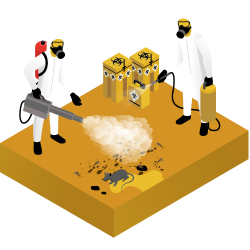
Certified disinfection
THE DEATHCLEAN® carries out, in a certified manner, using high-performance biocidal disinfectant products, the correct and proven disinfection of contaminated areas or areas at high risk of exposure to contamination.
We can only consider the disinfection service when it effectively involves the elimination of pests, as the disinfection service of contaminated places requires the elimination of microorganisms that transmit infectious diseases and not urban pests.
Our cleaning and disinfection service for crime or trauma scenes (suicides, homicides and decompositions) or cleaning interventions in other contaminated locations is not considered or classified as a disinfection service, but rather as a disinfection and decontamination service.




